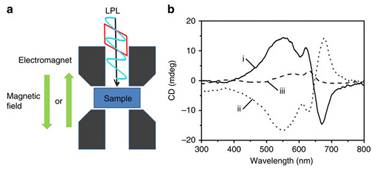The mystery of broken symmetry in the origin of life always attracts scientists. Associate Professor ZOU Gang and his team found a new way of controlled synthesis of helical conjugated polymers, which provides reference and enlightenment to this long-standing problem.
A chirality phenomenon is one that is not identical to its mirror image, and it is especially characteristic of life origin. Due to its wide existence in physics, chemistry, and life science, chirality has always been paid extensive attention by scientists in biological medicine and chemical materials. Helical conjugated polymers shows unique optical and electromagnetic properties and this lead it to broad application prospects in chiral separation, display materials, asymmetric electrode, biological medicine, etc. With recent development of asymmetric synthesis methods and techniques, researchers have gone much further from polymerization of chiral monomers, chiral modification of a chiral polymers, to chiral template-controlled polymerization and supra molecular assembly. However, efficient selective synthesis of helical conjugated polymers from achiral monomers with no chiral mobile phase additive remains unsolved.
In response to this challenge, ZOU and his team successfully implement the controlled synthesis of helical polydiacetylene for the first time by applying linear polarized light under a parallel or antiparallel magnetic field. As is known in the Faraday Effect, vibration direction of the light rotates if high-intensity magnetic field is applied parallel to its propagation direction. When a photochemical reaction is controlled under specifically-directed linear polarized light and magnetic field, it shows chiral selective properties. Based on this principle, ZOU and his team applied linear polarized light to the process of synthesizing helical polydiacetylene. The Circular Dichroism (CD) signal of this helical polydiacetylene is proportional to magnetic field and the signal intensity drastically changed with the rotation angle.


Figure: Scheme forasymmetric polymerization mechanism for the hydrogen-bonding (HB) complex samples prepared by application of linearly polarized light (LPL) and the magnetic field parallel to the irradiation direction
The research not only provides responsive chromatic materials towards chiral recognition of amino acid enantiomers, but also is of great fundamental value for a deeper understanding of the mirror symmetry breaking in photochemical reaction and biological molecules.
Associate professor ZOU Gang works at CAS Key Lab of Soft Matter Chemistry and also teaches at the Department of Polymer Science in School of Chemistry and Materials Science, USTC. This research titled “
Enantioselective synthesis of helical polydiacetylene by application of linearly polarized light and magnetic field” has been published online on
Nature Communications on Sept. 23th.
(CHE Yifeng, USTC News Center)